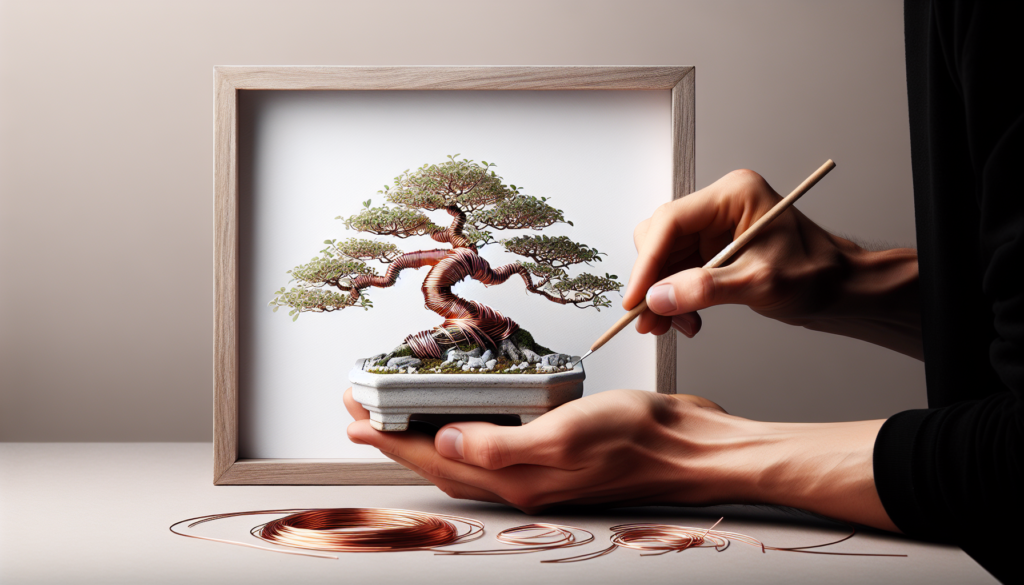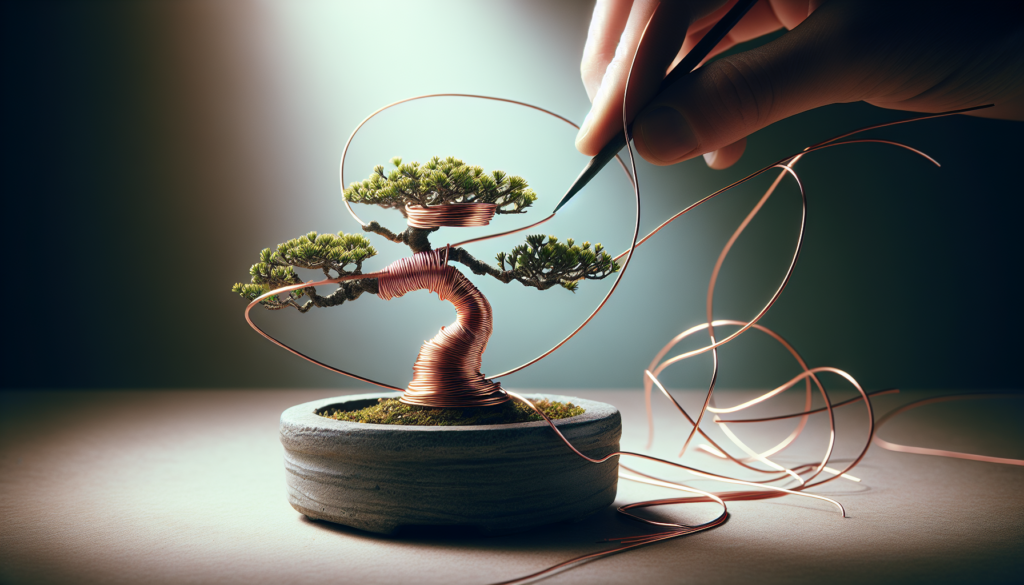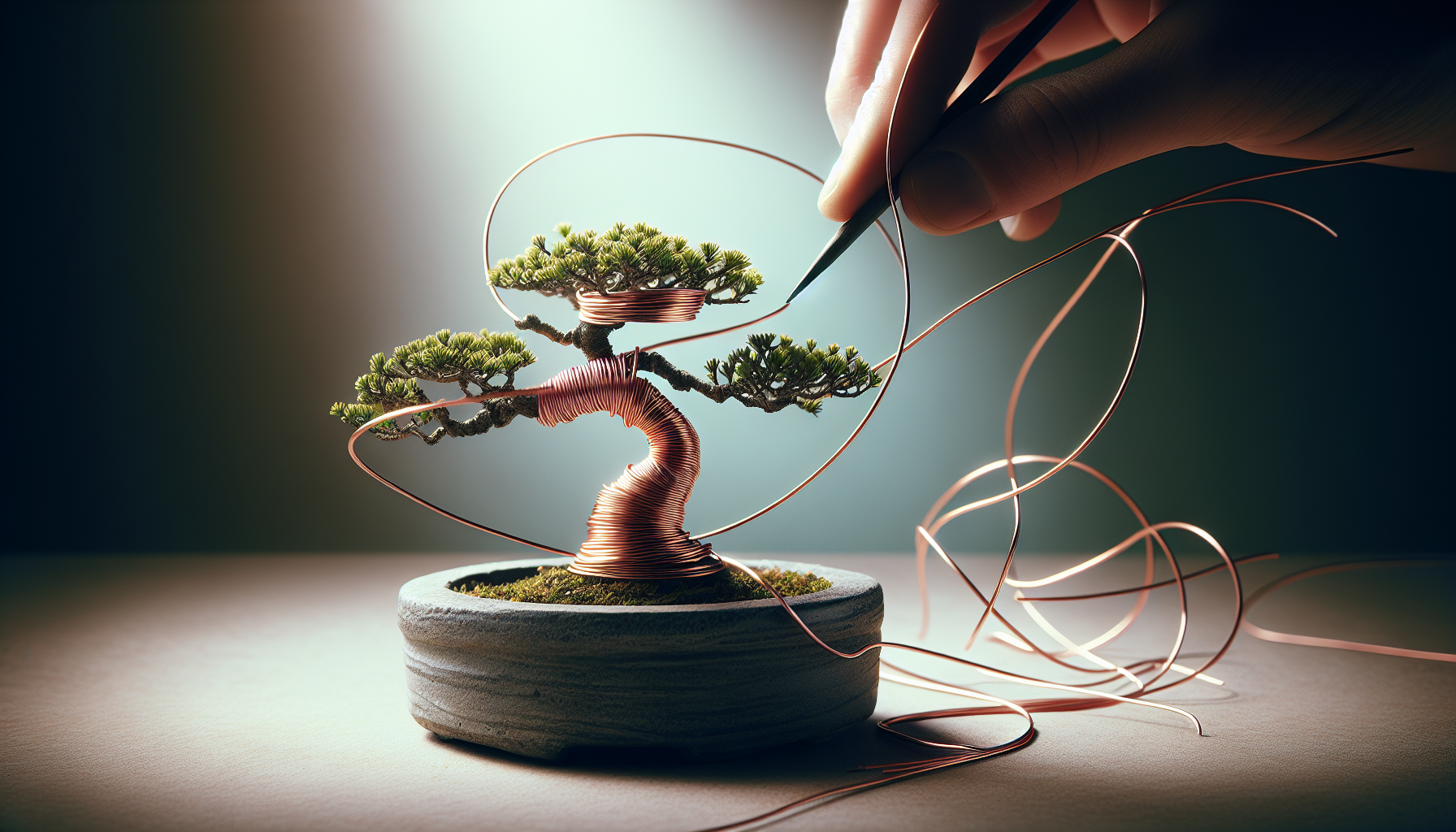Imagine you’re holding a pair of pliers in your hand, delicately twisting wires around the branches of a tiny tree, shaping it into an exquisite work of art. Bonsai wiring is a fascinating technique that allows you to create beautiful miniature trees, sculpting them according to your vision. In this beginner’s guide, we will walk you step-by-step through the art of bonsai wiring, providing you with the essential knowledge and techniques to begin your journey into this captivating world.

Understanding the Art of Bonsai Wiring
Bonsai wiring is an essential technique used by bonsai enthusiasts to create and shape the magnificent miniature trees known as bonsai. It allows for precise control over the growth and form of the tree, giving it the desired aesthetic appeal. By strategically wrapping wire around various branches and trunks, bonsai enthusiasts can guide their trees into elegant and artistic forms that mirror the beauty of full-sized trees in nature.
The Purpose of Bonsai Wiring
The primary purpose of bonsai wiring is to train the tree’s branches and trunk into pleasing shapes and positions. It allows you to bend and reposition the tree’s limbs, creating movement, balance, and harmony within the design. With proper wiring techniques, you can gently position branches at different angles, creating depth and dimension in the overall composition of your bonsai tree.
The Connection Between Bonsai Wiring and Tree Growth
Bonsai wiring works by applying pressure to the tree’s branches, which temporarily interrupts the flow of nutrients and water. This interruption stimulates the tree’s inherent response mechanism to grow new cells and strengthen the affected areas. Over time, the new growth molds to the wired position, creating a permanent change in the tree’s shape. It is essential to monitor the wire regularly to prevent it from cutting into the bark or restricting the flow of nutrients for an extended period, which could cause damage to the tree.
Basic Principles of Bonsai Wiring
When it comes to bonsai wiring, several fundamental principles should guide your approach. First, always be mindful of the health and well-being of the tree. Do not wire a tree that is weak or suffering from disease or stress. Second, consider the tree’s growth cycle and timing your wiring sessions accordingly. Wiring should ideally be done during the tree’s dormant season to minimize any stress on the tree. Third, remember that bonsai wiring is a gradual process. Avoid overbending or straining the branches to achieve immediate results. Patience and precision are key to successful bonsai wiring.
The Right Tools for Bonsai Wiring
Having the right tools is crucial for a successful bonsai wiring endeavor. Not only does it ensure a smoother process, but it also helps minimize any potential harm to the tree.
Types of Bonsai Wire
Bonsai wire comes in a variety of materials, including aluminum, copper, and annealed copper. Aluminum wire is the most common choice for beginners due to its affordability and flexibility. Copper wire, while more expensive, is preferred for more advanced bonsai enthusiasts as it retains its shape better and offers more strength for larger branches and trunks. Annealed copper wire, on the other hand, combines the best of both worlds – it is flexible and can be reshaped while providing strength.
Choosing the Right Wire Size
Selecting the appropriate wire size is crucial as it determines the effectiveness of your wiring technique. Generally, the wire’s thickness should be around one-third to one-half of the branch or trunk’s diameter. If the wire is too thin, it may not provide sufficient support, while wire that is too thick will be challenging to bend and shape. It’s essential to have a variety of wire sizes readily available to accommodate different branches and trunks on your bonsai tree.
Other Essential Tools for Bonsai Wiring
In addition to bonsai wire, there are a few other tools you should have in your arsenal for successful bonsai wiring. These include wire cutters or bonsai pliers for cutting and removing wires, raffia or tape for protecting delicate or sensitive areas of the tree, and a bending jack or a similar device for applying pressure and assisting in bending thicker branches or trunks.
Fundamental Bonsai Wiring Techniques
To master the art of bonsai wiring, it’s crucial to understand and practice fundamental wiring techniques. Here are three essential techniques that will help you shape your bonsai tree beautifully:
Single Branch Wiring
Single branch wiring involves selecting a single branch and wrapping wire around it in a spiral motion, starting from the base and working your way up to the tip. The wire should be wrapped tight enough to hold the branch in the desired position, but not too tight to cause damage. As you wrap the wire, make sure to leave sufficient space between each turn to allow for growth and to prevent wire scarring.
Double Branch Wiring
Double branch wiring, as the name suggests, involves wiring two branches together to create a harmonious and interconnected design. You start by wiring the primary branch, followed by the secondary branch. The wire should be wrapped clockwise around the primary branch and counter-clockwise around the secondary branch. By guiding the branches into a complementary shape, you can achieve a natural and balanced appearance.
Wiring a Bonsai Trunk
Wiring the bonsai trunk is more complex and requires careful consideration of the tree’s natural taper and movement. The wire should be wrapped diagonally and spiraled up the trunk, avoiding crossing over the branches. When wiring the trunk, it’s crucial to ensure the wire is not too tight, as it could restrict the tree’s flow of nutrients or cause unnecessary damage. It’s essential to regularly inspect the wire to prevent it from digging into the bark.
Guided Steps for Wiring Bonsai Trees
Now that you have a good understanding of the basic wiring techniques, let’s explore a guided approach to wiring your bonsai tree. This step-by-step process will help you achieve optimal results while minimizing any potential harm to the tree.
Starting with the Tree’s Lower Branches
Begin by selecting the lower branches that you want to wire first. It’s important to work from the bottom up to ensure balance and achieve a more natural appearance. Start by wrapping the wire around the base of the branch, ensuring it is secure but not too tight. Gradually move up the branch, following its natural curve, and continue wrapping the wire until you reach the tip. Avoid wiring branches that are too young or weak, as they are more susceptible to damage.
Approach for Wiring the Middle Branches
After completing the wiring of the lower branches, move on to the middle branches. Again, work systematically from the bottom up, wiring each branch individually. Take into account the tree’s overall design and desired shape, ensuring the branches complement one another. It’s crucial to avoid overcrowding or overwiring the branches, as this can lead to unnecessary stress on the tree and hinder its growth.
Handling the Upper Branches
Finally, tackle the upper branches of the bonsai tree. These branches are often thinner and more delicate, requiring extra care during the wiring process. Take your time and be patient, as precision is key. Consider the tree’s design and overall aesthetic, aiming for a balanced and visually appealing composition. It’s important to remember that the upper branches contribute significantly to the tree’s overall silhouette, so take special care in wiring them.

Proper Placement of Bonsai Wire
While understanding the various wiring techniques is important, knowing how to properly place the wire is equally crucial. Here are some guidelines to keep in mind when placing bonsai wire:
Ensuring Adequate Spacing
When wrapping wire around branches or trunks, it’s essential to leave enough space between each turn to allow for the tree’s growth and to prevent wire scarring. The spacing should be consistent and uniform throughout the wiring process to maintain an aesthetically pleasing appearance. Leaving a small gap between each turn of wire not only facilitates the tree’s growth but also makes it easier to remove the wire when it’s time.
Understanding Wire Angles
Wire angles play a vital role in achieving the desired shape and direction of the branches. When wiring a branch, start by observing its natural angle and movement. The wire should be wrapped in a way that follows the branch’s natural curve, enhancing its overall aesthetics. Avoid sharp angles or unnecessary strain on the branch, as this can lead to damage or weakened growth.
Guidelines for Wire Wrapping
When wrapping the wire around branches or trunks, there are a few guidelines to follow for optimal results. First, start at the base or bottom of the branch and work your way up towards the tip. This ensures stability and prevents the wire from slipping or loosening. Second, maintain an even tension throughout the wrapping process. The wire should be firm enough to hold the branch in place but not tight enough to cause harm. Lastly, avoid crossing the wire over itself, as this can create pressure points and restrict the flow of nutrients.
Avoiding Common Wiring Mistakes
While bonsai wiring is an art that allows for creativity and expression, it’s important to be aware of common wiring mistakes and how to avoid them. Here are a few common pitfalls to watch out for:
Over-wiring: Indications and Impacts
Over-wiring occurs when too many branches or areas of the tree are wired simultaneously or excessively. This can lead to unnecessary stress on the tree, hindering its growth and health. Signs of over-wiring include branches or trunk sections that appear constricted or exhibit signs of swelling. To avoid over-wiring, plan your wiring strategy beforehand, focusing on specific areas at a time, and ensure you give the tree enough recovery time between wiring sessions.
Incorrect Wire Placement: How to Spot and Rectify
Incorrect wire placement can occur when the wire is too tight, cutting into the bark, or causing damage to the branches. This can restrict the flow of nutrients and weaken the tree. To spot incorrect wire placement, regularly inspect the tree, paying attention to areas that show signs of constriction or discoloration. If you notice any issues, carefully remove the wire and replace it, ensuring proper placement and tension.
Dealing with Wire Scarring
Wire scarring refers to the marks or indentations left on the bark by the wire during the wiring process. While wire scarring is generally unavoidable, it can be minimized by using proper wire placement techniques and allowing sufficient space between each turn of wire. If wire scarring does occur, gently remove the wire when it is time, and allow the tree to recover and heal naturally. With time, new growth will cover the scars, restoring the tree’s aesthetic appearance.
After-Wiring Care and Maintenance
Once you have successfully wired your bonsai tree, it’s essential to provide appropriate care and maintenance to ensure its health and well-being. Here are some crucial steps to follow:
Monitoring Wire Tension
Regularly check the wire tension to ensure it is neither too loose nor too tight. As the tree grows, the wire may need to be adjusted or removed to prevent constriction or scarring. Make it a habit to inspect the tree every few weeks, gently feeling the wire to assess its tension and making any necessary adjustments.
Identifying When to Remove the Wire
Knowing when to remove the wire is equally important as it allows the tree to develop and grow freely. Removing the wire too early may result in the branches springing back to their original position, while leaving it on for too long can cause wire scarring or restrict the tree’s growth. As a general guideline, most deciduous trees can be wired for six to twelve months, while conifers may require a shorter duration. Regularly check the tree’s growth progress and remove the wire promptly once the desired shape or position is achieved.
Techniques for Safely Removing Bonsai Wire
Removing bonsai wire requires careful attention to avoid damaging the tree. Start by locating the wire’s ends and carefully unwind it in the reverse order of installation. Use wire cutters or bonsai pliers to cut the wire if it becomes entangled or difficult to unwind. As you remove the wire, do so gently, ensuring the tree’s branches or trunk are not strained or pulled. If any wire scarring is present, allow the tree time to heal naturally, and avoid re-wiring the same area until it has fully recovered.
Advanced Bonsai Wiring Techniques
Once you have mastered the fundamental bonsai wiring techniques, you can progress to more advanced techniques that cater to specific bonsai tree species or intricate designs. Here are a few advanced wiring techniques to explore:
Wiring Difficult Bonsai Trees and Branches
Some bonsai trees or branches may pose unique challenges due to their size, rigidity, or growth habits. For such cases, advanced wiring techniques can be employed, such as using guy-wire technique or multiple layers of wire to achieve the desired shape. These techniques require more experience and precision to execute successfully.
Wiring Techniques for More Complex Bonsai Forms
As you gain confidence in your wiring skills, you can experiment with more complex bonsai forms, such as cascade or literati styles. These styles often require more intricate wiring techniques to achieve the desired elegance and balance. It’s important to study and understand the specific wiring requirements for each style to ensure the best results.
Applying Guy-Wire Technique
The guy-wire technique involves using a separate wire or string attached to the branch or trunk and anchored to a fixed point, such as a stake in the pot. This technique allows for gentle and gradual bending of thicker branches or trunks without exerting excessive pressure. It is a valuable technique for shaping larger or more mature bonsai trees.
Bonsai Wiring and Seasonality
Considering the seasonality of bonsai wiring is crucial for the tree’s well-being and overall success. Here are some key considerations:
Ideal Seasons for Bonsai Wiring
The ideal seasons for bonsai wiring are during the tree’s dormant periods, typically in late winter or early spring and late autumn. During these periods, the tree is less prone to stress and has a reduced risk of damage to its new growth. Wiring during these seasons allows the tree ample time to recover and heal before the next growing season.
Considerations for Wiring in Different Seasons
If you find it necessary to wire your bonsai tree during the growing season, there are a few things to consider. First, avoid wiring during extreme weather conditions, such as heatwaves or freezing temperatures, as these can further stress the tree. Second, monitor the tree closely and provide appropriate care, such as regular watering and fertilizing, to support its recovery. Lastly, be mindful of the tree’s growth rate during the season, as wired branches may require more frequent adjustments to prevent constriction.
Seasonal Bonsai Maintenance Tips
Proper seasonal maintenance is essential for the health and vitality of your bonsai tree. In addition to wiring, consider other maintenance tasks specific to the season. This may include pruning, repotting, pest control, and adjusting watering and fertilizing routines. By following a comprehensive maintenance plan tailored to each season, you will ensure the long-term success and beauty of your bonsai tree.
Learning from Bonsai Masters
To truly excel in the art of bonsai wiring, it is beneficial to learn from experienced bonsai masters and draw inspiration from their work. Here are a few ways to incorporate their expertise into your own practice:
Incorporating Concepts from Japanese Bonsai Masters
Japanese bonsai masters have a profound understanding of bonsai techniques, aesthetics, and traditions. Studying their work and incorporating their concepts into your own practice can enhance your understanding of the art form. Explore Japanese bonsai books, attend workshops or seminars, or join bonsai clubs to gain insights from knowledgeable bonsai enthusiasts.
Exploring Noteworthy Bonsai Creations
Exposing yourself to a variety of bonsai creations can inspire and deepen your appreciation for the art form. Visit bonsai exhibitions, both locally and globally, to observe and study different bonsai styles, techniques, and species. Take note of the wiring techniques used in these creations and consider how they can inform your own work.
Continuous Learning and Improvement in Bonsai Wiring Techniques
Bonsai wiring is an ongoing learning process that requires patience, curiosity, and a willingness to continuously improve. As you gain experience, seek out opportunities to refine your techniques, experiment with new approaches, and share your knowledge with other bonsai enthusiasts. Remember that mastery of bonsai wiring is a lifelong journey, and each tree presents a unique challenge and opportunity for growth.
In conclusion, bonsai wiring is an art that requires knowledge, skill, and patience. By understanding the purpose and principles of bonsai wiring, equipping yourself with the right tools, mastering fundamental techniques, and practicing proper wire placement, you can shape and sculpt your bonsai tree into a work of living art. With continuous learning and care, you will develop your own unique style and contribute to the enduring legacy of bonsai enthusiasts around the world. Happy wiring!








